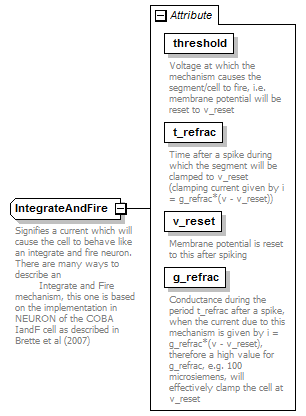<xs:complexType name="IntegrateAndFire">
<xs:annotation>
<xs:documentation>Signifies a current which will cause the cell to behave like an integrate and fire neuron. There are many ways to describe an Integrate and Fire mechanism, this one is based on the implementation in NEURON of the COBA IandF cell as described in Brette et al (2007)</xs:documentation>
</xs:annotation>
<xs:attribute name="threshold" type="bio:VoltageValue" use="required">
<xs:annotation>
<xs:documentation>Voltage at which the mechanism causes the segment/cell to fire, i.e. membrane potential will be reset to v_reset</xs:documentation>
</xs:annotation>
</xs:attribute>
<xs:attribute name="t_refrac" type="bio:TimeValue" use="required">
<xs:annotation>
<xs:documentation>Time after a spike during which the segment will be clamped to v_reset (clamping current given by i = g_refrac*(v - v_reset))</xs:documentation>
</xs:annotation>
</xs:attribute>
<xs:attribute name="v_reset" type="bio:VoltageValue" use="required">
<xs:annotation>
<xs:documentation>Membrane potential is reset to this after spiking</xs:documentation>
</xs:annotation>
</xs:attribute>
<xs:attribute name="g_refrac" type="bio:ConductanceValue" use="required">
<xs:annotation>
<xs:documentation>Conductance during the period t_refrac after a spike, when the current due to this mechanism is given by i = g_refrac*(v - v_reset), therefore a high value for g_refrac, e.g. 100 microsiemens, will effectively clamp the cell at v_reset</xs:documentation>
</xs:annotation>
</xs:attribute>
</xs:complexType> |
